Chiniot – the name is enough to start the furniture lovers, travelers and cautiously curious dreaming. Antiquity is the first message of the town. And, international quality furniture “made in Chiniot” is collectors delight with potentials for marketing all over the world.
On the bank of River Chenab in area called Sandal Bar, Chiniot town is an exotic place in the foot of series of hillocks that seem to be man made rather than evidence of old mountains.
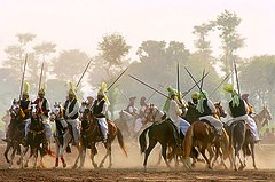 The town is very ancient. It was inhabited before the time when Alexander of Macedon came in the South Asia and was principal city during the rule of White Huns. Chinese explorer Hiuen Tsiang visited it. Alberuni has mentioned in Kitabul-Hind that Chiniot was one of the there most important places in this part of the world.
The town is very ancient. It was inhabited before the time when Alexander of Macedon came in the South Asia and was principal city during the rule of White Huns. Chinese explorer Hiuen Tsiang visited it. Alberuni has mentioned in Kitabul-Hind that Chiniot was one of the there most important places in this part of the world.
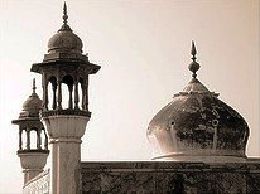 Chiniot suffered much from the Durrani inroads during the last half of the eighteenth century and also during the troubles of I848 because it remained the scene of constant fierce struggle among the leaders of local factions. As per the local legend, portion of the wall, surviving in situ, had been built during Hellenic period. The veracity of the wall’s association with Alexander the great is yet to be proven though. But the sit does give evidence of its distant past.
Chiniot suffered much from the Durrani inroads during the last half of the eighteenth century and also during the troubles of I848 because it remained the scene of constant fierce struggle among the leaders of local factions. As per the local legend, portion of the wall, surviving in situ, had been built during Hellenic period. The veracity of the wall’s association with Alexander the great is yet to be proven though. But the sit does give evidence of its distant past.
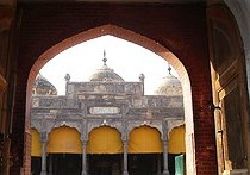 During the Mughal era, Chiniot produced many intelligent personalities and talented artisans who occupied positions in the Mughal courts, Nawab Saad Ullah Khan and Nawab Wazir Khan held the post of Prime Minister of India and the Governor of Lahore respectively during the rule of King Shah Jehan.
During the Mughal era, Chiniot produced many intelligent personalities and talented artisans who occupied positions in the Mughal courts, Nawab Saad Ullah Khan and Nawab Wazir Khan held the post of Prime Minister of India and the Governor of Lahore respectively during the rule of King Shah Jehan.
Artisans of Chiniot have instinctive good taste and they have achieved a distinctive excellence in woodwork. Masons of the town are said to have been employed during the construction of Taj Mahal at Agra and Golden Temple at Amritsar. Special type of furniture with brightly lacquered woodcarving is made in Chiniot and is famous all over the world.
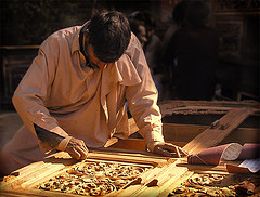 What this internationally acclaimed craft of the town needs is an institutional patronization and extensive efforts for international marketing? Made in Chiniot furniture is already being shipped to different countries but so far there are very little marketing efforts being made for this purpose. It can be a potent source of earning foreign exchange if attention is paid to and earnest efforts are made. Sadly, the trained incompetents responsible for export promotion do not see this and the unique potentials are not being taped yet. The first exhibition of Chinioti furniture in Islamabad last year was attended by large number of people from all walks of life. Particularly foreigners appreciated the furniture for its style, solidity and the cost.
What this internationally acclaimed craft of the town needs is an institutional patronization and extensive efforts for international marketing? Made in Chiniot furniture is already being shipped to different countries but so far there are very little marketing efforts being made for this purpose. It can be a potent source of earning foreign exchange if attention is paid to and earnest efforts are made. Sadly, the trained incompetents responsible for export promotion do not see this and the unique potentials are not being taped yet. The first exhibition of Chinioti furniture in Islamabad last year was attended by large number of people from all walks of life. Particularly foreigners appreciated the furniture for its style, solidity and the cost.
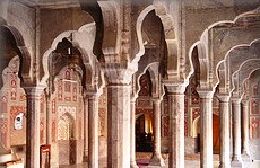 Apart from furniture, there are more attractions for any visitor to this off the beaten track tranquil town. A towering architectural masterpiece Shahi Mosque, which was built during rule of Mughal King Shah Jehan by Nawab Saad Ullah Khan in 1655, is still functional. It resembles the Shahi Mosque Delhi that was also built under the supervision of Nawab Saad Ullah Khan. After the invasions of British, the city lost its old glory and importance. However, the historical buildings and their ruins are scattered in and around the city, reflect its wonderful past.
Apart from furniture, there are more attractions for any visitor to this off the beaten track tranquil town. A towering architectural masterpiece Shahi Mosque, which was built during rule of Mughal King Shah Jehan by Nawab Saad Ullah Khan in 1655, is still functional. It resembles the Shahi Mosque Delhi that was also built under the supervision of Nawab Saad Ullah Khan. After the invasions of British, the city lost its old glory and importance. However, the historical buildings and their ruins are scattered in and around the city, reflect its wonderful past.
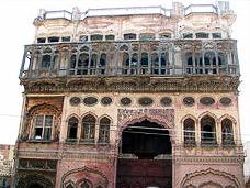 Another such building is the Umar Hayat Palace commonly known as the Gulzar Mahal. Attracting local and foreign tourist, it is known for its beauty and legendary tales attached to it. The palace is said to have been built by Sheikh Umar Hayat, a rich merchant whose family originally migrated to Chiniot from India.
Another such building is the Umar Hayat Palace commonly known as the Gulzar Mahal. Attracting local and foreign tourist, it is known for its beauty and legendary tales attached to it. The palace is said to have been built by Sheikh Umar Hayat, a rich merchant whose family originally migrated to Chiniot from India.
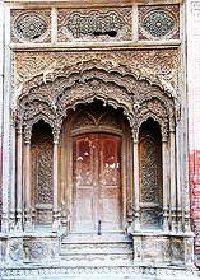 Legend has it that in a village fair at Panda Haitian, Umar Hayat fell in love with a performer girl and married. She bore him a son and a daughter. Umar Hayat grew particularly fond of his son whom he named Gulzar – a rose garden or a sign of happiness. It was for his son that Umar Hayat decided to construct a wonderful palace and name after him. Umar Hayat could not see the palace completed and later his son Gulzar died mysteriously in the palace in the early hours of his marriage night.
Legend has it that in a village fair at Panda Haitian, Umar Hayat fell in love with a performer girl and married. She bore him a son and a daughter. Umar Hayat grew particularly fond of his son whom he named Gulzar – a rose garden or a sign of happiness. It was for his son that Umar Hayat decided to construct a wonderful palace and name after him. Umar Hayat could not see the palace completed and later his son Gulzar died mysteriously in the palace in the early hours of his marriage night.
A different tale reveals that the construction of the palace was a result of rivalry between Umar Hayat and Elahi Baksh – a famous artisan of the time. The latter taunted the Umar Hayat by saying that his artistic abilities were superior to all the wealth in the world. Infuriated, Umar Hayat counter claimed that his money would last long enough to buy all the possible feats skilled artisans could offer.
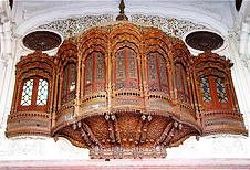 The result of the challenge was the creation of Gulzar Manzil. The construction of the palace started in 1923 and Umar Hayat lavishly spent his wealth. According to one account, the supervision of the construction was assigned to Syed Hassan Shah who gathered famous artisans and carried out day and night work for ten years. Elahi Baksh and Rahim Baksh did the wood carving, for which the palace is known. Both were masters of the art. The Punjab District Gazetteers reads:
The result of the challenge was the creation of Gulzar Manzil. The construction of the palace started in 1923 and Umar Hayat lavishly spent his wealth. According to one account, the supervision of the construction was assigned to Syed Hassan Shah who gathered famous artisans and carried out day and night work for ten years. Elahi Baksh and Rahim Baksh did the wood carving, for which the palace is known. Both were masters of the art. The Punjab District Gazetteers reads:
“The house built by Sheikh Umar Hayat is a sort of wonder.”
The imposing building is a work of art. The woodwork, the stucco work, inlay of bricks, use of marbles and floral design in the roof, stairways and balconies are living memories of the glories of the Mughal period. Very elaborate and extensive woodwork in the palace speak of the craftsmanship of the artisans who perfected it beyond amazing limits. One has to possess a sensibility shaped in granite not to be moved after seeing the woodwork even today.
The palace originally had six stories including a basement. Two of the upper stories decayed and had to be demolished in 1978. Remains of the building are in the care and custody of Auqaf. Presently it is in public use and houses a library section and a small museum.
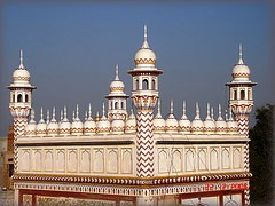 Chiniot, a market town in the expanses of Punjab bears a prosperous look. Chiniot has every thing necessary for development – hard working and talented people, fertile land, water, communication infrastructure and clean healthy environment. The furniture industry can be converted into important source of earning though efficient ‘marketing mix’. Given chance Chiniot can be a nice and rich little city of the future.
Chiniot, a market town in the expanses of Punjab bears a prosperous look. Chiniot has every thing necessary for development – hard working and talented people, fertile land, water, communication infrastructure and clean healthy environment. The furniture industry can be converted into important source of earning though efficient ‘marketing mix’. Given chance Chiniot can be a nice and rich little city of the future.
Photo Credits: Photos for this article have been taken from flickr.com. Clicking on the photos will take you to their source and larger image sizes.
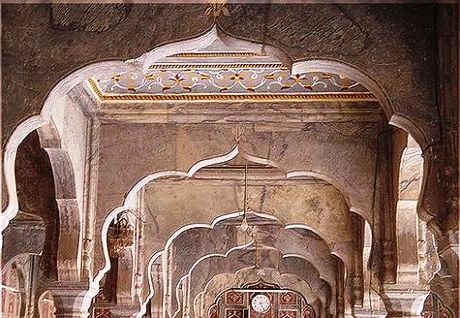




















































>>>The furniture industry can be converted into important source of earning though efficient
Tina:
Just a tiny, teeny bit of correction. Sheesham is a hardwood, not softwood. Walnut is a softwood.
But you are right, there is not enough wood in Pakistan to sustain large scale export of furniture.
the work of wood which i have seen here is really remarkable, fascinating, gorgeous, splendid and beautiful. I have for the very first time experiance to seek such a nice piece of master piece of wood-work. I do really appreciate the worker who has performed this excellent work with his able hand and he must have used his experince of his whole life to accomplish this magnificent work. I am fully guy after seeing this work.Only an expert critic can in fact make count of all the qualities of this work but a lay person like me can only observe this work with open eyes.So,this work really represents pakistani culture and its essence and it also does highlight the historical aspects of muslims way and style of the construction of the building and i am myself very happy to see it and i can well remember the splendid period of muslim rulars who were fond to make such beautiful and seenable buildings.This work would prove very crucial for the students of history and it will enhance the knowledge of historians who visit several places only for the purpose of discovering new things and this masterpiece will really prove helpful for them and they will be able to even write books in which work of wood, crafts, design would be favoured.
Lovely post. Simply wonderful.Its been a couple of years since i had the pleasure of being there. but my parents were born in chiniot so i have lived my share in this busy and quaint town.
Thanks you for rekindling these memories with this post.and yes most of the chiniot sheikh braderi is now in karachi with very few back in chinot but these folks are still doing a lot of welfare activities which inclide the chiniot islamia hospital and other charitable organizations.
My forefathers settled in Chiniot once they moved from Delhi in the 1750s, and lived there till my parents and their siblings moved out of it in the 60s and the 70s. Yet I have visited this place many a times though the have visited it only once after my childhood.
I never felt any love for the place while I was young. It looked all dirty and filthy to me, with mass of dirty children stalking the streets. Yet it seemed to have a culture of its own, with its own tazianas that they take out on Muharram, the kind one would not find any where else.
Yet one thing has always amazed me. Chiniot, a small town or city, on the banks of River Chanab, and has existed for hundreds of years, has yet lost its signifiance just because somewhere in the 1910s – or is it 1920s? – the British Raj built a new city from scratch, Faisalabad, which is just 35 Kms from Chiniot. That hotch potch of businesses and labor, what was originally called Lyallpoor, has got anything but culture, and thus despite its size could never match the grandeur of Lahore or the indigenous culture of Chiniot. I still wonder what got into the head of the British not to build a Faisalabad out of Chiniot? Then it would have been a commercial as well as a cultural and historical hub, all in one.